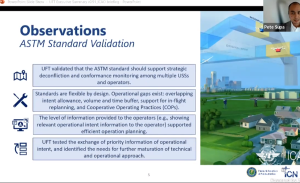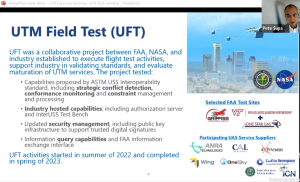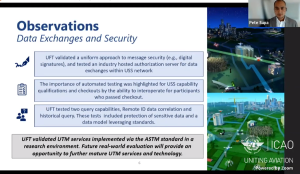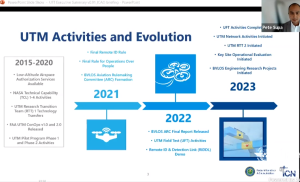By Jenny Beechener
The US Federal Aviation Administration (FAA) has concluded 12 months’ of field testing to test and validate technologies and standards to support UAS Traffic Management (UTM). Ahead of publication of the final report, Tritana (Pete) Supamusdisukul, Project Manager in the FAA’s Operations and New Entrants Division shared some initial findings during the ICAO Drone Enable webinar broadcast on 14 November.
Consensus-based standards under development by the FAA provided an effective “method to support de-conflictions to enable safe & scalable interop operations, particularly for increasingly complex operations, and should be considered best practice,” said Pete Supa. However, standards are flexible by design, and the FAA anticipates Cooperative Operating Practices (COPs) to manage operational gaps and ensure safety within different applications. He emphasised the role that UAS service providers can play in helping operators to “more effectively replan and reroute flight without too many trials and errors” by providing information about surrounding operations.

The UTM Field Test (UFT) is based on FAA, NASA collaborative work on standards development to enable drones to operate in the same airspace safely. “The biggest objective is ability for multiple drone operations, using different service suppliers, to interoperate. This includes strategically deconflicting from each other, and from airspace constraints in shared airspace,” said Pete Supa. This was enabled by standards allowing UAS service providers to exchange information using the same common data exchange protocol; for example, to ensure there is no conflict before the flight takes place, or if so, operators are able to dynamically replan or reroute flights.

The FAA UFT carried out over 800 live flights primarily with two test-site partners: Griffiss International Airport and Virginia Tech, New York; and the Mid-Atlantic Aviation Partnership in partnership with Lone Star UAS Excellence, Texas. In both cases, the tests involved many participating partners including UAS service providers such as ANRA Technologies, AXA Enterprize, CAL Analytics, Collins Aerospace, OneSky, Wing, among others. The UFT activities started in summer 2022 and concluded in summer 2023.
Using FAA consensus-based standards, test site partners conducted complex use cases and scenarios between summer 2022 and summer 2023. UAS service providers used centralised capabilities to de-conflict routes with other operators while taking into account airspace constraints and other operations with elevated priority. This was enabled by FAA standards that allow for service providers to exchange services using same common data exchange protocol.

The tests also focused on the ability of service suppliers to support the operator in monitor conformance of operations to ensure they stayed within the airspace volume. In addition to standards, the FAA tested security management processes to support message signing with trusted signatures; software validation; and data exchange identify information to access historical data within the service provider network.

Pete Supa believes that “real-world evaluation will be the key to further refine and mature the technologies” and supports organic use of the technology. “The use of data sharing agreements, standards, and a consensus-based approach by the UTM community will help to ensure quality of service and interoperability in the real-world,” he concluded.
The FAA plans to publish final UFT reports on the website in near future:
https://www.faa.gov/uas/research_development/traffic_management/field_test
(Image: Shutterstock)




